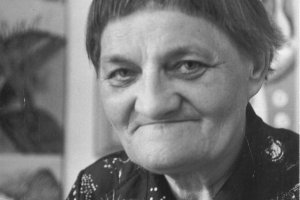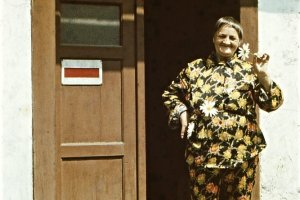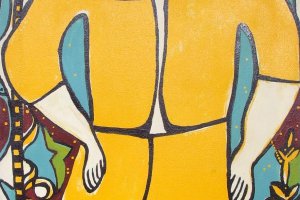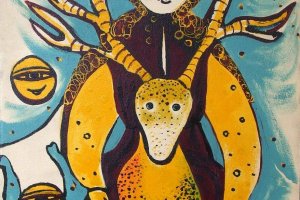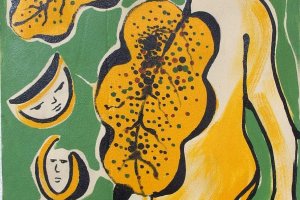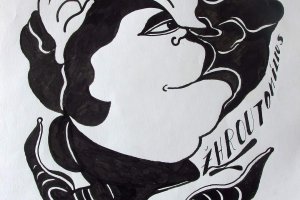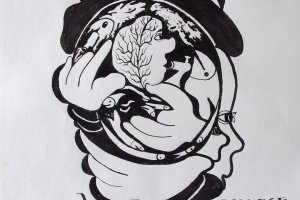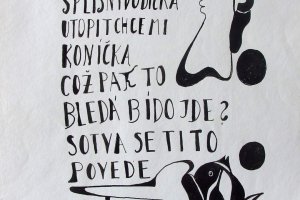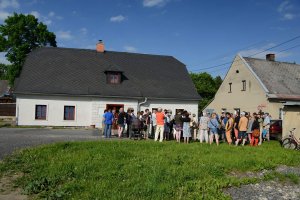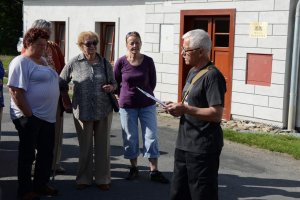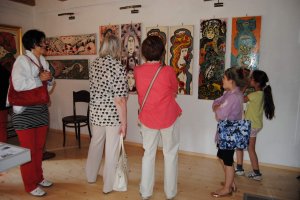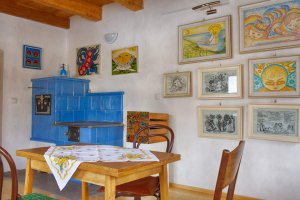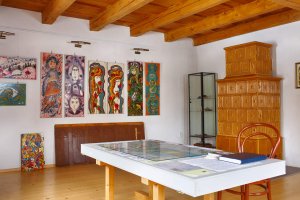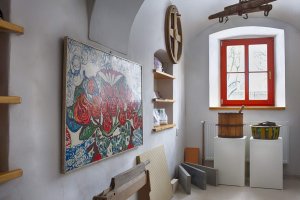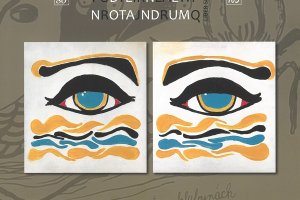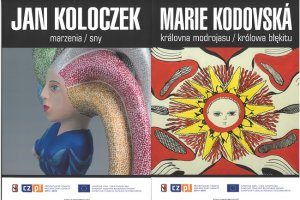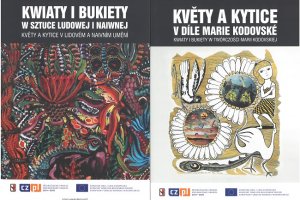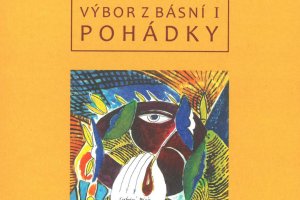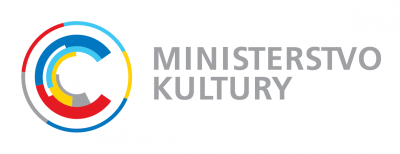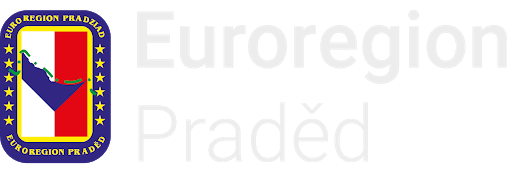Marie Kodovská gallery
address
Marie Kodovská gallery
private gallery
Mlýnská street 21, 795 01 Rýmařov
Ing. František Orság
operator
Mobile: +420 733 429 438
e-mail: forsajt@seznam.cz
opening hours
May – September
Tuesday + Thursday + Saturday
9:00-12:00, 13:00-16:00
other date for ordering on mobile phone +420 733 429 438
admission
50 CZK (basic)
25 CZK (reduced)
100 CZK (family fee; max. 5 people, 2 adults and 3 children)
10 CZK (school trips)
Marie Kodovská (1912–1992) was an important art brut artist and a naive poet. She came to Rýmařov with her family from Korytná near Uherský Brod in 1945. For the rest of her life, she was intensively engaged in writing poems and, from 1964, when she was 52 years old, also in visual arts (paintings on sololith, drawings, collages, statues, etc.). Marie Kodovská's private gallery is located in her house on Mlýnská Street. In the reconstructed premises, the author's artwork and objects she used can be seen.
Marie Kodovská was born on 21st January 1912 as the elder of twins in a family settled in the poor village of Korytná near Uherský Brod. Father Antonín Kodovský (1877–1944) came from Hrádek u Slavičína and was orphaned as a child. Mother Kateřina, née Nováková, (1879–1955) came from Korytná. They met in 1900 in Vienna, where they both went to work. Together they returned to Korytná to Kateřina's parents and later built a house. They had nine children: František, Josef, Jan, Karel, Antonín and Maria, Anna, Josef and František. Only four of them lived to adulthood.
The war years marked the family with frequent deaths, Marie herself suffered wartime flu and severely burned her right hand, which remained almost paralyzed despite several operations. She spent her childhood in poor conditions and working hard in the fields. At the age of twenty-three, her mother married her to a carpentry apprentice, Jan Bětík (1911–1974), with whom she gave birth to three children: Vladimír (*1936), Jiřina (*1937) and Stanislav (*1945).
After the war, in order to ensure better conditions for her children, Marie decided to move with her family to the border town of Rýmařov. Bětík did not agree, but when Marie got a job at the Brokát textile factory and arranged to rent and later buy a house after the transferred Germans, he had to accept his wife's decision. Marie worked in a textile factory until 1955, when she was granted a disability pension.
Magdalena's Fate, the oldest surviving collection of poems still in manuscript, dates from that time. Due to her husband's displeasure, she wrote her texts secretly, hiding them and destroying them.
However, she gradually won the right to her own creation. In the 1950s, she published in the Brokát magazine and became part of the selection of so-called folk creativity in the anthology Ešče lepší bude (1954). She regularly sent her poems to Czechoslovak Radio, from where she received a typewriter in 1960. The year 1964 is considered to be the beginning of her creative work, and from the beginning the author signed her works with her maiden name.
Kodovská's work would certainly not be so extensive and diverse if it were not for her son Vladimír and his physical, material and psychological help. He helped with the organisation of the first solo exhibitions in Rýmařov and Ryžoviště (1972), in collaboration with Jindřich Štreit in Sovinec (1974), with Alena Nádvorníková in Olomouc (1976) and in Brno (1976). Kodovská's works were also exhibited at fifty collective exhibitions. She participated in the 1st Czech exhibition of amateur art in Šumperk (1970) and in a number of exhibitions in art centres around the world (e.g. Prague, Nuremberg, Bilbao, Madrid, Dresden, Berlin, Boston, Desava, Tokyo, Paris). At the Šumperk exhibition, she received an Honourable Mention from the Ministry of Culture.
Although she wrote and painted every day, her most significant period was the 1970s, in which she created dozens of large-format enamels, drawings, collages and wrote over twenty volumes of poems. The death of her husband in 1974 meant for her an official return to her maiden surname as well as a creative coping with an unhappy period of marriage (e.g. the collections Revealed Secret, Echoes of Own Blood). In the 1980s, she did not exhibit as much, but she remained in the consciousness of collectors and art historians. In 1981, Jan Slavotínek recorded the radio program about her life and work Old Woman Kodovská – the unknown voice of the heart, which was broadcast by Czechoslovak Radio. A year later, a two-page article was dedicated to her in the cultural-historical weekly magazine Tvorba, and in 1991 also in the women's magazine Vlasta.
Marie Kodovská died on 12th November 1992 in the Rýmařov hospital at the age of eighty. Until the last moments of her life, she wrote, painted and drew. Her house full of paintings began to fall into decay and her legacy was slowly fading away.
While Kodovská's work was classified as naive art until 1989, after the fall of the communist regime it was re-evaluated by Alena Nádvorníková, in the context of Central European art brut work at legendary exhibitions in Prague (1998) and Olomouc (2008). To commemorate the half-forgotten poet and painter, Zdenka Přikrylová Nesetová initiated the creation of a nationwide literary and art competition named after Marie Kodovská at the local newspaper Rýmařovský horizont, which was held for six years.
In 2012, 2013, 2015 and 2016, the Octopus Gallery at the Rýmařov Town Museum organised a series of exhibitions entitled Marie Kodovská – known and unknown. Since 2015, the Marie Kodovská Gallery has been open, located in the author's reconstructed house at Mlýnská street 21, which is run by Ing. František Orság. Rýmařov Town Museum in cooperation with Vladimír Kodovský, Ing. František Orság and the Museum Wsi Opolskiej in Opole published two catalogues, Volume I (Fairy Tales) and II (Sci-fi and dreams) of the planned four-volume Committee on the Poems of Marie Kodovská.

 English (United Kingdom)
English (United Kingdom)  Polski (PL)
Polski (PL)  Czech (Čeština)
Czech (Čeština) 
